Related Research Articles
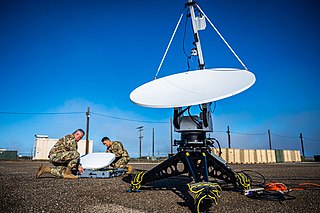
Electromagnetic warfare or electronic warfare (EW) is warfare involving the use of the electromagnetic spectrum or directed energy to control the spectrum, attack an enemy, or impede enemy operations. The purpose of electromagnetic warfare is to deny the opponent the advantage of—and ensure friendly unimpeded access to—the EM spectrum. Electromagnetic warfare can be applied from air, sea, land, or space by crewed and uncrewed systems, and can target communication, radar, or other military and civilian assets.

Eglin Air Force Base is a United States Air Force (USAF) base in the western Florida Panhandle, located about three miles (5 km) southwest of Valparaiso in Okaloosa County.
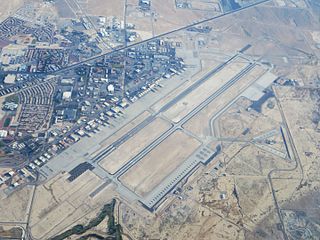
Nellis Air Force Base is a United States Air Force installation in southern Nevada. Nellis hosts air combat exercises such as Exercise Red Flag and close air support exercises such as Green Flag-West flown in "Military Operations Area (MOA) airspace", associated with the nearby Nevada Test and Training Range (NTTR). The base also has the Combined Air and Space Operations Center-Nellis.

Hunter Army Airfield, located in Savannah, Georgia, United States, is a military airfield and subordinate installation to Fort Stewart located in Hinesville, Georgia.

Naval Surface Warfare Center Crane Division is the principal tenant command located at Naval Support Activity Crane. NSA Crane is a United States Navy installation located approximately 25 miles (40 km) southwest of Bloomington, Indiana, and predominantly located in Martin County, but small parts also extend into Greene and Lawrence counties. It was originally established in 1941 under the Bureau of Ordnance as the Naval Ammunition Depot for the production, testing, and storage of ordnance under the first supplemental Defense Appropriation Act. The base is named after William M. Crane. The base is the third largest naval installation in the world by geographic area and employs approximately 3,300 people. The closest community is the small town of Crane, which lies adjacent to the northwest corner of the facility.

The U.S. Army Test and Evaluation Command, or ATEC, is a direct reporting unit of the United States Army responsible for developmental testing, independent operational testing, independent evaluations, assessments, and experiments of Army equipment.
The United States biological weapons program officially began in spring 1943 on orders from U.S. President Franklin Roosevelt. Research continued following World War II as the U.S. built up a large stockpile of biological agents and weapons. Over the course of its 27-year history, the program weaponized and stockpiled the following seven bio-agents :
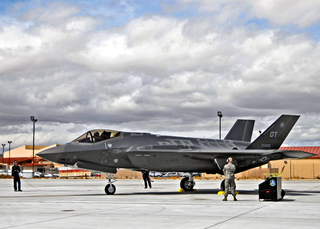
The 53rd Wing is a wing of the United States Air Force based at Eglin Air Force Base, Florida. The wing reports to the United States Air Force Warfare Center at Nellis Air Force Base, Nevada, which in turn reports to Headquarters Air Combat Command.
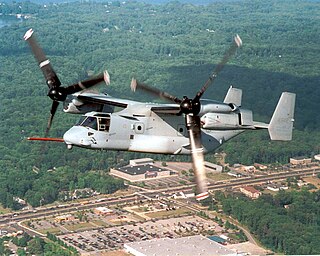
The 18th Special Operations Test and Evaluation Squadron is an active unit of the United States Air Force, based at Hurlburt Field, Florida. The squadron performs field testing for Air Force Special Operations Command, evaluating aircraft, equipment, and tactics in realistic battlespace environments to provide decision-makers with accurate, timely, and complete assessments of mission capability. From concept development to system fielding, the unit's mission improves the survivability and combat capability of special operations forces worldwide.

The United States Air Force Warfare Center (USAFWC) at Nellis Air Force Base, Nevada, reports directly to Air Combat Command. The center was founded on September 1, 1966, as the U.S. Air Force Tactical Fighter Weapons Center. It was renamed the U.S. Air Force Warfare Center in 2005.
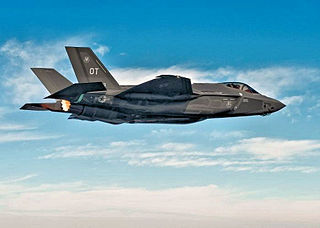
The 422d Test and Evaluation Squadron is a United States Air Force unit. It is assigned to the 53d Test and Evaluation Group, stationed at Nellis Air Force Base, Nevada. The squadron performs operational testing of all fighter aircraft and munitions entering and in operational use by Air Combat Command.

The Deseret Test Center was a U.S. Army operated command in charge for testing chemical and biological weapons during the 1960s. The Deseret was headquartered at Fort Douglas, Utah, a former U.S. Army base.
Entomological warfare (EW) is a type of biological warfare that uses insects to interrupt supply lines by damaging crops, or to directly harm enemy combatants and civilian populations. There have been several programs which have attempted to institute this methodology; however, there has been limited application of entomological warfare against military or civilian targets, Japan being the only state known to have verifiably implemented the method against another state, namely the Chinese during World War II. However, EW was used more widely in antiquity, in order to repel sieges or cause economic harm to states. Research into EW was conducted during both World War II and the Cold War by numerous states such as the Soviet Union, United States, Germany and Canada. There have also been suggestions that it could be implemented by non-state actors in a form of bioterrorism. Under the Biological and Toxic Weapons Convention of 1972, use of insects to administer agents or toxins for hostile purposes is deemed to be against international law.
Operation Drop Kick was conducted between April and November 1956 by the US Army Chemical Corps to test the practicality of employing mosquitoes to carry an entomological warfare agent in different ways. The Chemical Corps released uninfected female mosquitoes into a residential area of Savannah, Georgia, whose residents had agreed to participate in the project, and then estimated how many mosquitoes entered houses and bit people. Within a day, many reports of mosquito bites were received. In 1958, the Chemical Corps released 1,000,000 mosquitoes in Avon Park, Florida.

Operation Big Itch was a U.S. entomological warfare field test using uninfected fleas to determine their coverage and survivability as a vector for biological agents. The tests were conducted at Dugway Proving Ground in 1954.
Operation Big Buzz was a U.S. military entomological warfare field test conducted in the U.S. city of Savannah, Georgia in 1955. The tests involved dispersing over 300,000 mosquitoes from aircraft and through ground dispersal methods.
The E14 munition was a cardboard sub-munition developed by the United States biological weapons program as an anti-crop weapon. In a series of field tests in 1955, the E14 was loaded with fleas and air-dropped.
The E23 munition was a cardboard sub-munition developed by the United States biological weapons program for use as an anti-crop weapon. The E23 underwent a conversion for use as a vector weapon and was briefly used in large-scale entomological warfare trial but technical issues forced it from the tests.
Operation Magic Sword was a 1965 U.S. military operation designed to test the effectiveness of the sea-borne release of insect vectors for biological agents.

Interactive Scenario Builder (Builder) is a modeling and simulation, three-dimensional application developed by the Advanced Tactical Environmental Simulation Team (ATEST) at the Naval Research Laboratory (NRL) that aids in understanding radio frequency (RF) and electro-optical/infrared (EO/IR) propagation.
References
- ↑ Rose, William H. "An Evaluation of Entomological Warfare as a Potential Danger to the United States and European NATO Nations", U.S. Army Test and Evaluation Command, Dugway Proving Ground, March 1981, via thesmokinggun.com , accessed December 25, 2008.